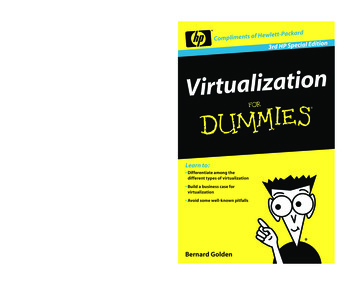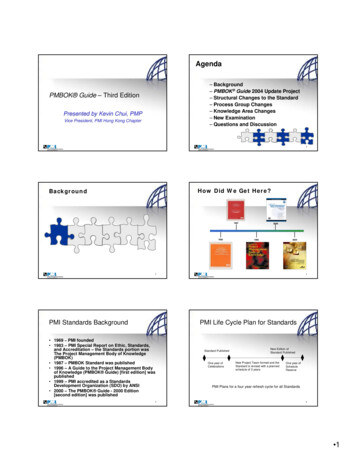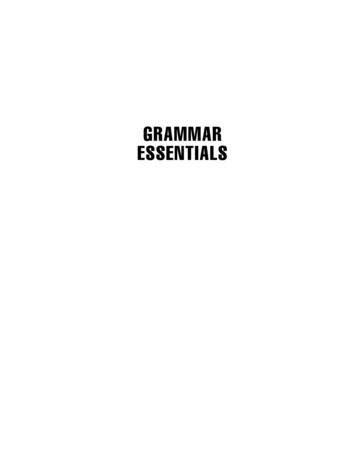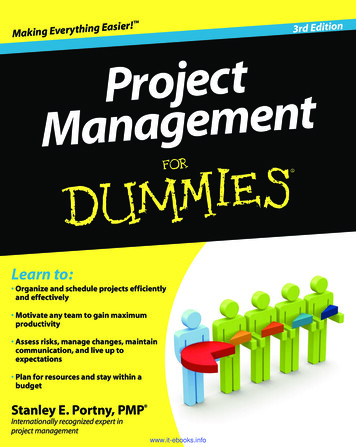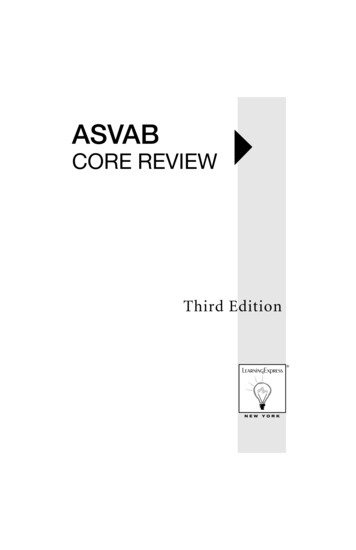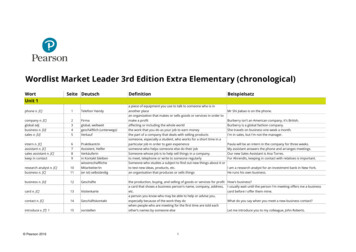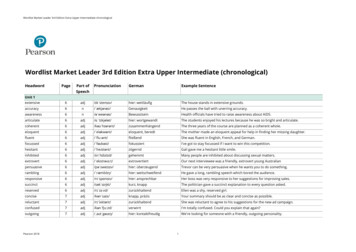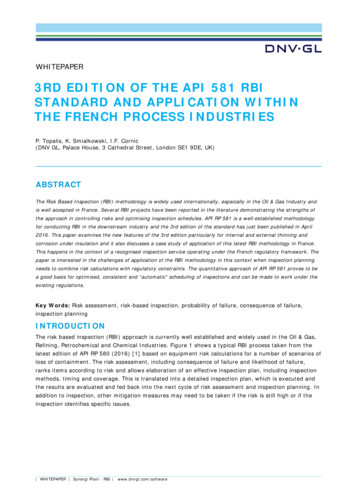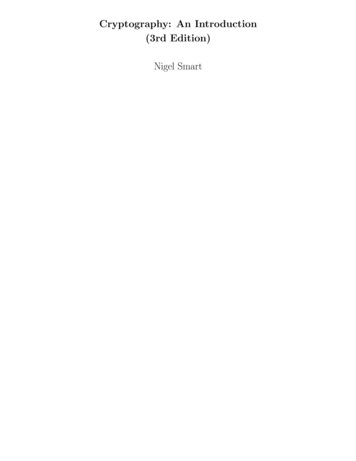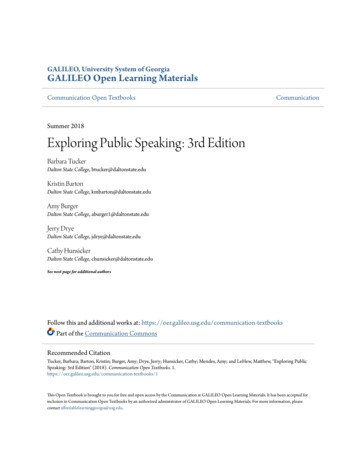
Transcription
GALILEO, University System of GeorgiaGALILEO Open Learning MaterialsCommunication Open TextbooksCommunicationSummer 2018Exploring Public Speaking: 3rd EditionBarbara TuckerDalton State College, btucker@daltonstate.eduKristin BartonDalton State College, kmbarton@daltonstate.eduAmy BurgerDalton State College, aburger1@daltonstate.eduJerry DryeDalton State College, jdrye@daltonstate.eduCathy HunsickerDalton State College, chunsicker@daltonstate.eduSee next page for additional authorsFollow this and additional works at: sPart of the Communication CommonsRecommended CitationTucker, Barbara; Barton, Kristin; Burger, Amy; Drye, Jerry; Hunsicker, Cathy; Mendes, Amy; and LeHew, Matthew, "Exploring PublicSpeaking: 3rd Edition" (2018). Communication Open Textbooks. oks/1This Open Textbook is brought to you for free and open access by the Communication at GALILEO Open Learning Materials. It has been accepted forinclusion in Communication Open Textbooks by an authorized administrator of GALILEO Open Learning Materials. For more information, pleasecontact affordablelearninggeorgia@usg.edu.
AuthorsBarbara Tucker, Kristin Barton, Amy Burger, Jerry Drye, Cathy Hunsicker, Amy Mendes, and MatthewLeHewThis open textbook is available at GALILEO Open Learning Materials: s/1
Exploring Public SpeakingiExploring Public Speaking:The Free Dalton State CollegePublic Speaking Textbook3rd EditionA Creative Commons LicensedOpen Educational Resourcefor Introductory College Public Speaking Courses
Exploring Public SpeakingiiPrimary Author and Editor: Dr. Barbara G. TuckerContributors:Ms. Amy BurgerMr. Jerry DryeMs. Cathy HunsickerMs. Amy MendesMr. Matthew LeHewConsultants:Mr. Nick CartyMs. Kim CorrellMs. Jackie DanielsDr. Clint KinkeadDr. Sarah MinDr. Tami TomaselloIn Memory of Dr. Kristin Barton, Originator of the Project and First EditorFor questions regarding this textbook, contact:Dr. Barbara G. TuckerDepartment of CommunicationDalton State College650 College DriveDalton, GA 30720Lorberbaum Liberal Arts 107B(706) 272-4411btucker@daltonstate.edu
Exploring Public SpeakingiiiThis text exists under a Creative Commons Attribution-Noncommercial-ShareAlike 4.0 License, and as such it may be used for non-commercial purposes. Any portion of this text may be altered or edited; however,author attribution is required, and if you remix, transform, or build uponthe material, you must distribute your contributions under the same license as the original. Portions of this text were adapted from a free, opensource textbook without attribution as requested by the work’s originalcreator(s) and licensee(s). The authors of Exploring Public Speakingrequest that you let them know if you plan to use all or a major part of thistextbook as a primary text for your basic communication classes. a rel ”license” href /” img alt ”Creative Commons License” style ”border-width:0”src ”https:// i.creativecommons.org/l/by-nc-sa/4.0/80x15.png” / /a br / span xmlns:dct ”http://purl.org/dc/terms/” href ”http://purl.org/dc/dcmitype/Text” proper- ty ”dct:title” rel ”dct:type” ExploringPublic Speaking: The Free Dalton State Col- lege Public Speaking Textbook /span by span xmlns:cc ”http:// creativecommons.org/ns#”property ”cc:attributionName” Barbara G. Tucker & Kristin M. Barton /span is licensed under a a rel ”license” href ”http:// creativecommons.org/licenses/by-nc-sa/4.0/” Creative Commons Attribution- NonCommercial-ShareAlike 4.0 International License /a .Photographs are used by permission of the Office of Marketing and Communication at Dalton State College and are copyrighted 2017.
Exploring Public SpeakingivIntroduction to ThirdEdition of ExploringPublic SpeakingExploring Public Speaking: The Free College Public Speaking Textbookbegan as the brainchild of Dr. Kris Barton, Chair of the Department ofCommunication at Dalton State College. It also was made possible througha generous Textbook Transformation Grant in 2015 from Affordable Learning Georgia, a highly successful program of the University System of Georgia. Dr. Barton asked me to help him author/compile the text.The goal was to provide a high-quality, usable, accessible, and low-costtextbook for the hundreds of students who take COMM 1110 at DaltonState College every year. This course is required of all degree-seeking students. We have been able to save students hundreds of thousands of dollarsalready with this text. Unexpectedly and happily, the text has also beendownloaded close to 14,000 times (as of August 2018) all over the worldand has been adopted at many other institutions.Dr. Barton and I worked on creating the textbook from July 2015 until May2016, with the goal of going live with the text in Summer of 2016. Tragically Dr. Barton passed away in early May, a reality that still does not seemreal. He has been greatly missed as a friend, colleague, father, scholar,teacher, and mentor.The launch of the book proceeded; however, due to the loss of Dr. Barton,the ancillaries were not finished. In Summer 2017 I took on a significantrevision and updating which I named the Second Edition. I included inthat edition information on college student success in the appendices. InJanuary 2018, a colleague, Matthew LeHew, and I won a grant from theUniversity System to create the ancillaries and improve the format for moreaccessibility. I decided to remove the “Dalton State” from the title andmost examples for wider appeal. An appendix on library research retainsthe information for specific use of Roberts Library on our campus.Over 90% of the book is original with Dr. Barton, me, or other colleagues atDalton State College. Some parts, specifically from Chapters 9, 10, and 15,are adapted from another open resource public speaking text whose authorprefers not to be cited.This Third Edition, along with including necessary updates and being formatted with different software, includes four more appendices: one on online speaking, one on APA, one on humor and storytelling in public speaking, and one on Dalton State’s Library. I have also tried to clarify concepts,
Exploring Public Speakingvto provide “case studies” to show the rhetorical process, and include moreoutlines and examples. We think this book is especially useful in coverageof PowerPoint, audience responsiveness, ethics in public speaking, specialoccasion speeches, and structure of speeches. Three ancillaries are available: electronic “flash cards” for study, Powerpoints on the 15 main chapters, and test banks for the 15 main chapters.Thank you for downloading Exploring Public Speaking, and the co-authorsand I truly wish you happy teaching and learning with it. We welcome input. If you choose to use it, let us know at btucker@daltonstate.edu.
Exploring Public SpeakingiTable of ContentsIntroduction to Third Edition of Exploring Public Speaking. ivChapter 1: The Basics of Public Speaking.11.1 – What is Public Speaking?. 21.2 – Anxiety and Public Speaking. 41.3 - Understanding the Process of Public Speaking.101.4 – The Value of Public Speaking in Your Life.151.5 – Getting Started in Public Speaking.16Chapter 2: Audience Analysis and Listening. 202.1 – The Importance of Audience Analysis.212.2 – Demographic Characteristics.212.3 – Psychographic Characteristics. 292.4 – Contextual Factors of Audience Analysis. 342.5 – Listening in Public Speaking Settings. 36Chapter 3: Ethics in Public Speaking. 433.1 – Sources of Ethical Stances on Communication and Public Speaking. 443.2 – Credibility and Ethics.483.3 – Plagiarism. 50Chapter 4: Developing Topics for Your Speech.604.1 – Getting Started with Your Topic and Purpose.614.2 – Formulating a Specific Purpose Statement. 624.3 – Formulating a Central Idea Statement.684.4 – Problems to Avoid with Specific Purpose and Central Idea Statements. 71Chapter 5: Researching Your Speeches.775.1 – Primary and Secondary Research. 785.2 – Research on the Internet. 795.3 – Conducting Your Own Research. 855.4 - Accessing Information Through a Library.88
Exploring Public SpeakingiiChapter 6: Organizing and Outlining Your Speech. 956.1 – Why We Need Organization in Speeches. 966.2 - Patterns of Organization.986.3 – Connective Statements. 1066.4 – Outlining.111Chapter 7: Supporting Your Speech Ideas. 1147.1 – Why Supporting Materials are Needed. 1157.2 – Types of Supporting Materials.1197.3 – Attention Factors and Supporting Material.133Chapter 8: Introductions and Conclusions.1398.1 – General Guidelines for Introductions and Conclusions. 1408.2 – Structuring the Introduction. 1418.3 – Examples of Introductions.1528.4 – Structuring the Conclusion.1548.5 – Examples of Conclusions. 160Chapter 9: Presentation Aids in Speaking.1629.1 - What Are Presentation Aids?.1639.2 – Functions of Presentation Aids.1649.3 – Types of Presentation Aids.1729.4 – Using Presentation Slides.1879.5 – Low-Tech Presentation Aids. 198Chapter 10: Language.20210.1 – What Language Is and Does.20310.2 – Standards for Language in Public Speaking.20610.3 – Developing Your Ability to Use Effective Language in Public Speaking.217Chapter 11: Delivery.22011.1 – The Importance of Delivery.22111.2 – Methods of Speech Delivery.
able: electronic “flash cards” for study, Powerpoints on the 15 main chap-ters, and test banks for the 15 main chapters. Thank you for downloading Exploring Public Speaking, and the co-authors and I truly wish you happy teaching and learning with it. We welcome in-put. If you choose to use it, let us know at btucker@daltonstate.edu.
